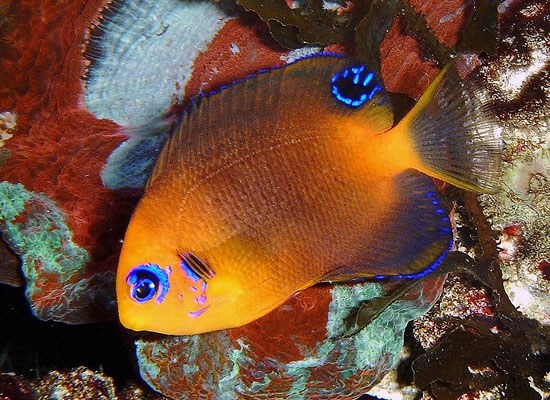
The Easter Island Dwarf Angelfish (aka Hotumatua Angel) is regarded by rare fish aficionadosas as one of a few ‘holy grail’ angelfishes. Less than a dozen ‘live specimen’ photos exist. At present time, I am not aware of any captive specimen in the United States.
Centropyge hotumatua is one of the least collected dwarf angelfish because of its limited natural range. This species is endemic to Easter Island – a remote Polynesian island located in the southeast Pacific. By remote, i really mean remote (see the Google map below).

The water temperatures around Easter Island range from 73°F (22.6°C) to 76°F (24.7°C), with a mean temperature of 75°F (23.7°C). While the biodiversity and density of Easter Island’s reefs are not as rich as those found in the warmer and less isolated Indo-Pacific, this island is still home to some of the world’s most exotic rocky coral reefs. Due to its isolation, it is also home to several unique species, including Centropyge hotumatua.
http://www.youtube.com/watch?v=esBkRvmcilQ
Hotumatua Angels were infrequently available in the late 1990s and early 2000s; Only a handful were collected annually, with most being shipped to Asia (where they commanded the highest prices). Today, they are non-existent in the aquarium trade. Very few hobbyist have had the opportunity to keep (or see) Centropyge hotumatua in captivity; I am fortunate enough to have cared for two specimens during my 20+ year reefkeeping “career.” It has been a decade since I’ve kept them, and just as long since I’ve seen C.hotumatua in the aquarium trade. The logistics of collecting and transporting live specimens from Easter Island have proven too impractical.
My first C.hotumatua was purchased in the late 1990s through The Marine Center (Texas). At the time, The Marine Center was one of the few livestock vendors in the United States receiving rare fishes. I received a 2″ specimen in great shape, and it quickly adapted to captive life within my 120 gallon mixed reef aquarium – despite the aquarium temperature of 78-80°F. My specimen was very passive … perhaps the least aggressive Centropyge I have owned. It spent most of its day out in the open foraging. Like nearly all dwarf angelfish, the Easter Island Angelfish readily accepted most foods. Its captive diet mainly consisted of mysis shrimp, brine shrimp, and Ocean Nutrition Prime Reef (frozen food). Unfortunately, my specimen also had a taste for SPS polyps. After several months of constant nipping, I was forced to remove the angelfish and sell it to another hobbyist who had a suitable FOWLR aquarium.
This broke my heart, so when I had another opportunity to buy another Hotumatua Angel the following year (this time, a tiny 1″ specimen), I quickly jumped at the chance. Unfortunately, this specimen was also a coral-nipper, though not as destructive as its predecessor. And even more unfortunate: I didn’t get a chance to try and remove it before the angel mysteriously disappeared. A few years later, while upgrading my 120 gallon to my current 176 gallon aquarium, imagine my surprise when I find the dried-up body of my missing Hotumatua behind my stand. Apparently, it had jumped!
In December, 2006, J. Charles Delbeek M.Sc. shared with Advanced Aquarist the history of rare fish exhibited at Waikiki Aquarium, which included a Centropyge hotumatua. Below is a photo of their Centropyge hotumatua.
-

- Hotumatua’s Pygmy Angelfish, Centropyge hotumatua Randall and Caldwell 1973. Photo by J.C. Delbeek, courtesy Waikiki Aquarium.
He writes:
Rarely collected due to its isolated habitat in the southeastern Pacific, Hotumatua angels do well in captivity. The Aquarium exhibited this fish from 1998 to 2001 until it disappeared from its display tank. It was housed on the same tank as the Colin’s and Golden angels without problem. The fish fed on flake food, gel diet and mysis without difficulty. It occasionally picked at corals but was not seen to be a big problem. This fish is currently in culture and captive bred specimens may appear on the market. Currently this species is available once or twice a year through exporters in Hawaii, the majority of these are sent to Japan where profit margins are much higher than in America or Europe.
Despite breeding efforts, no captive bred specimens have ever made it into the aquarium trade as far as I know, and I am not aware of anyone currently breeding the species … or even having a live specimen in captivity for that matter.
I would not be surprised if we do not see any more specimens making their way into the aquarium trade in the immediate future, but I would be happy to be proven wrong.










0 Comments